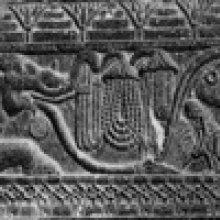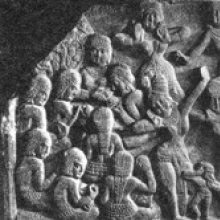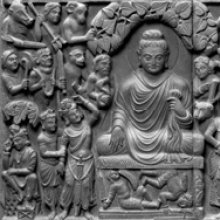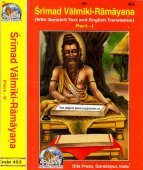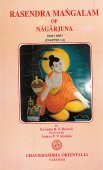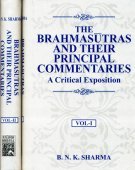Vidya, Vidyā: 42 definitions
Introduction:
Vidya means something in Buddhism, Pali, Hinduism, Sanskrit, Jainism, Prakrit, the history of ancient India, Marathi, Hindi. If you want to know the exact meaning, history, etymology or English translation of this term then check out the descriptions on this page. Add your comment or reference to a book if you want to contribute to this summary article.
Images (photo gallery)
(+7 more images available)
In Hinduism
Shaivism (Shaiva philosophy)
Source: Wisdom Library: Śaivism1) Vidyā (विद्या):—Second of the five factors of limitation (kañcuka) that occur in the second stage during the unity of Śiva and Śakti (subject and object). Their unity is initiated upon the cosmic process of creation.
2) Vidyā (विद्या):—Third of the eight Mātṛs born from the body of Mahimā, according to the Kubjikāmata-tantra. These eight sub-manifestations (mātṛ) are associated with the (element) earth. The first five from (including Vidyā) represent the five kalās. All these eight mātṛs are characterized as carrying a diamond in their hand. They are presided over by the Bhairava Jhaṇṭa and his consort named Aindryā. Mahimā is the seventh of the Eight Mahāmātṛs, residing within the Mātṛcakra (third of the five cakras) and represents the earth.
Source: bhagavadgitausa.com: Kashmir SaivismVidya: Normally Siva is Omniscient (Sarvajnatva). Maya has put a crimp on this all-knowing facility and rendered the individual soul with limited knowledge.
Source: Brill: Śaivism and the Tantric TraditionsVidyā (विद्या, “gnosis”) or Jñāna (doctrine) refers to one of the four categories of the subject-matter of the Āgamas, according to Alexis Sanderson in his 2006 article on the Lākulas (before presenting the vratas in the ninth chapter of the caryāpāda of the Mataṅgapārameśvara).—The Śaivas have conventionally divided the means of liberation taught in the Āgamas, that is to say their subject matter, into the four categories, ritual (kriyā), doctrine or gnosis (jñāna, vidyā), meditation (yoga), and ascetic observance and other rules governing the conduct of the various classes and kinds of initiate (caryā).

Shaiva (शैव, śaiva) or Shaivism (śaivism) represents a tradition of Hinduism worshiping Shiva as the supreme being. Closely related to Shaktism, Shaiva literature includes a range of scriptures, including Tantras, while the root of this tradition may be traced back to the ancient Vedas.
Shaktism (Shakta philosophy)
Source: Wisdom Library: ŚāktismVidyā (विद्या, “Knowledge”):—One of the female offspring from Mahākālī (tamas-form of Mahādevī). Mahākālī is one of the three primary forms of Devī, the other two being Mahālakṣmī and Mahāsarasvatī. Not to be confused with Kālī, she is a more powerful cosmic aspect (vyaṣṭi) of Devi and represents the guṇa (universal energy) named tamas. Also see the Devī Māhātmya, a Sanskrit work from the 5th century, incorporated into the Mārkaṇḍeya-Purāṇa.
Source: Wisdom Library: Śrīmad Devī BhāgavatamVidyā (विद्या, “knowledge”):—One of the names attributed to Devī, as chanted by the Vedas in their hymns, who were at the time incarnated in their personified forms. See the Devī-bhāgavata-purāṇa chapter 5.51-68, called “the narrative of Hayagrīva”.
Source: Google Books: ManthanabhairavatantramVidyā (विद्या) refers to one of the eight Kaula consorts (dūtī-aṣṭaka) associated with Nādapīṭha (identified with Kulūta), according to the Manthānabhairavatantra, a vast sprawling work that belongs to a corpus of Tantric texts concerned with the worship of the goddess Kubjikā.—[...] The eight Kaula consorts (dūtyaṣṭaka): Nivṛti, Pratiṣṭhā, Vidyā, Śānti, Kāladūtī, Mahārāvā, Rati, Prītikarī.
Source: JSTOR: Tāntric Dīkṣā by Surya KantaVidyā (विद्या) refers to one of the five Kalās mentioned in Śāradātilaka I.26. Kalā represents one of the six adhvans being purified during the Kriyāvatī-dīkṣā: an important Śākta ritual. Dīkṣā is one of the most important rituals of the Śāktas and so called because it imparts divine knowledge and destroys evil.
Source: Brill: Śaivism and the Tantric Traditions (shaktism)Vidyā (विद्या) is another name for Goddess Nityā, according to the King Vatsarāja’s Pūjāstuti called the Kāmasiddhistuti (also Vāmakeśvarīstuti), guiding one through the worship of the Goddess Nityā.—Accordingly, “[...] O mother! Even the kings of gods bow to the feet of those men who have acquired a drop of the grace of seeing you. [...] Mindful men call you Kledanī, Kulakuṇḍalinī, Kā, Nityā, Nīti, Nau, Nāvikā, Vidyā, Saṃvid, Vīśvamayī, Umā, Kāmeśvarī, and Kamalā”.

Shakta (शाक्त, śākta) or Shaktism (śāktism) represents a tradition of Hinduism where the Goddess (Devi) is revered and worshipped. Shakta literature includes a range of scriptures, including various Agamas and Tantras, although its roots may be traced back to the Vedas.
Dharmashastra (religious law)
Source: Google Books: Manusmṛti with the ManubhāṣyaThe term ‘knowledge,’ ‘vidyā,’ stands for that by means of which all things are known; i.e., the reading of the text as well as the grasping of the meaning. The meaning is that he who does not bring any benefit should not be taught the text of the Veda, nor should the explanation of tho meaning of Vedic texts be expounded to him. (see the Manubhāṣya, II.112)

Dharmashastra (धर्मशास्त्र, dharmaśāstra) contains the instructions (shastra) regarding religious conduct of livelihood (dharma), ceremonies, jurisprudence (study of law) and more. It is categorized as smriti, an important and authoritative selection of books dealing with the Hindu lifestyle.
Purana and Itihasa (epic history)
Source: archive.org: Puranic Encyclopedia1) Vidyā (विद्या).—A maid of Devī Umā. (Mahābhārata, Vana Parva, Chapter 231, Stanza 48).
2) Vidyā (विद्या).—A deity. This deity is worshipped as the deity of three Vedas which are the most important of the religious or Vedic literature. Mention is made about this deity in the preface of Ṛgvedabhāṣya by Sāyaṇa, as follows.
2) Once Vidyā approached a Brahmin and said "I am your wealth. Your duty is to impart me to disciples who are pure, celibate, law-abiding and active, and who protect the treasure. I hate disciples who are jealous."
Source: archive.org: Shiva Purana - English Translation1) Vidyā (विद्या) refers to a “learning”, which is mentioned as obtainable through the worship of Śiva, according to the Śivapurāṇa 2.1.14:—“[...] a person desirous of learning (vidyā-kāma) shall worship half that number [for details, see text]. A person desirous of eloquence shall worship Śiva with ghee”.
2) Vidyā (विद्या) refers to the “[various] lores”, and represents an epithet of Śiva used in Sandhyā’s eulogy of Śiva, according to the Śivapurāṇa 2.2.6. Accordingly:—“[...] Directly perceiving the lord of Durgā she [viz., Sandhyā] eulogised the lord of the worlds: [...] Thou art, the greatest supreme soul. Thou art Śiva, the various (vividha) lores (vidyā), the pure Brahman, the supreme Brahman and the utmost object of deliberation”.
Source: Cologne Digital Sanskrit Dictionaries: The Purana Index1a) Vidyā (विद्या).—Leads to happiness: Role of teacher and pupil. A means to attain final beatitude;1 of 18 groups—also 14 groups;2 survive antarkṣaya.3
- 1) Bhāgavata-purāṇa XI. 10. 12; 11. 4-7; VI. 16. 27.
- 2) Brahmāṇḍa-purāṇa III. 35. 88-9; III. 15. 29; IV. 12. 57; 18. 46; 34. 69.
- 3) Matsya-purāṇa 2. 13.
1b) A śakti.*
- * Brahmāṇḍa-purāṇa IV. 35. 98; 44. 57, 140.
1c) Not to have marital alliances with Viśvāmitras, Khili Khilis, etc.*
- * Matsya-purāṇa 198. 21.
1d) 14 including Mimāṃsa, Nyāya, Purāṇa, Dharmaśāstra,—18 in number,—also includes Āyurveda. Dhanurveda, Gāndharva, and Arthaśāstra;1 four Anvīkṣikī. Trayī, Vārta and Daṇḍanīti;2 another division—Parā and Aparā.3
Source: JatLand: List of Mahabharata people and placesVidyā (विद्या) refers to the name of a Tīrtha (pilgrim’s destination) mentioned in the Mahābhārata (cf. III.82.47). Note: The Mahābhārata (mentioning Vidyā) is a Sanskrit epic poem consisting of 100,000 ślokas (metrical verses) and is over 2000 years old.
Source: Shodhganga: The saurapurana - a critical studyVidyā (विद्या) refers to one of the various kinds of articles used for donation, according to the 10th century Saurapurāṇa: one of the various Upapurāṇas depicting Śaivism.—Accordingly, the tenth chapter contains the praise and classification of donations. It narrates the characteristics of proper recipients and the results of giving different kinds of articles like Bhūmi, Vidyā, Anna, Jala, Tila, Vāsa, Dīpa, Yāna, Śayyā, Dhānya, Aśva, Śāka, Indhana, Chatra, Auṣadha, Go, etc.

The Purana (पुराण, purāṇas) refers to Sanskrit literature preserving ancient India’s vast cultural history, including historical legends, religious ceremonies, various arts and sciences. The eighteen mahapuranas total over 400,000 shlokas (metrical couplets) and date to at least several centuries BCE.
Dhanurveda (science of warfare)
Source: Wisdom Library: DhanurvedaVidyā (विद्या) refers to a weapon (knowledge, science, learning, scholarship). It is a Sanskrit word defined in the Dhanurveda-saṃhitā, which contains a list of no less than 117 weapons. The Dhanurveda-saṃhitā is said to have been composed by the sage Vasiṣṭha, who in turn transmitted it trough a tradition of sages, which can eventually be traced to Śiva and Brahmā.

Dhanurveda (धनुर्वेद) refers to the “knowledge of warfare” and, as an upaveda, is associated with the Ṛgveda. It contains instructions on warfare, archery and ancient Indian martial arts, dating back to the 2nd-3rd millennium BCE.
Nyaya (school of philosophy)
Source: Shodhganga: A study of Nyāya-vaiśeṣika categoriesVidyā (विद्या, “valid knowledge ”) refers to one of two types of Buddhi (cognition) according to Praśastapāda in the Vaiśeṣikadarśanam with Praśastapādabhāṣya.—According to Praśastapāda, buddhi is divided into two kinds:—vidyā (valid knowledge) and avidyā (invalid knowledge). Valid knowledge has four kinds–perception, inference, recollection and supernormal occult perception. Invalid knowledge has also four kinds–doubt, illusion, indefinite knowledge and dream.
Source: academia.edu: Religious Inclusivism in the Writings of an Early Modern Sanskrit Intellectual (nyaya)Vidyā (विद्या) refers to “branches of knowledge” or “sciences”, according to Jayanta Bhaṭṭa (ninth–tenth century), the great Naiyāyika from Kashmir, who was a close reader of Kumārila’s work. Like him, he ascribes authority to branches of knowledge or ‘sciences’ (vidyā, vidyāsthāna) that derive from the Vedic tradition.

Nyaya (न्याय, nyaya) refers to a school of Hindu philosophy (astika), drawing its subject-matter from the Upanishads. The Nyaya philosophy is known for its theories on logic, methodology and epistemology, however, it is closely related with Vaisheshika in terms of metaphysics.
Kavya (poetry)
Source: archive.org: Naisadhacarita of SriharsaVidyā (विद्या) refers to the “different branches of learning”, and is mentioned in the Naiṣadha-carita 1.4, 5. The vidyās are referred to as being fourteen and eighteen in number. The fourteen sciences are the four Vedas and their six Aṅgas, Mīmāṃsā, Nyāya, the Law Books and the Purāṇas. In verse 1.5 the number is spoken of as being eighteen (agāhatāṣṭādaśatāṃ) by including Medicine, Military Art, Music and Polity.

Kavya (काव्य, kavya) refers to Sanskrit poetry, a popular ancient Indian tradition of literature. There have been many Sanskrit poets over the ages, hailing from ancient India and beyond. This topic includes mahakavya, or ‘epic poetry’ and natya, or ‘dramatic poetry’.
Vaishnavism (Vaishava dharma)
Source: Pure Bhakti: Bhagavad-gita (4th edition)Vidyā (विद्या) refers to “knowledge”. (cf. Glossary page from Śrīmad-Bhagavad-Gītā).

Vaishnava (वैष्णव, vaiṣṇava) or vaishnavism (vaiṣṇavism) represents a tradition of Hinduism worshipping Vishnu as the supreme Lord. Similar to the Shaktism and Shaivism traditions, Vaishnavism also developed as an individual movement, famous for its exposition of the dashavatara (‘ten avatars of Vishnu’).
Vedanta (school of philosophy)
Source: Shodhganga: Siva Gita A Critical StudyVidyā (विद्या) or Vidyāgītā refers to one of the sixty-four Gītās commonly referred to in Hindu scriptures.—Gītā is the name given to certain sacred writings in verse (often in the form of a dialogue) which are devoted to the exposition of particular religious and theosophical doctrines. Most of these Gītās [i.e., Vidyā-gītā] originate from the Mahābhārata or the various Purāṇas.

Vedanta (वेदान्त, vedānta) refers to a school of orthodox Hindu philosophy (astika), drawing its subject-matter from the Upanishads. There are a number of sub-schools of Vedanta, however all of them expound on the basic teaching of the ultimate reality (brahman) and liberation (moksha) of the individual soul (atman).
Ayurveda (science of life)
Source: gurumukhi.ru: Ayurveda glossary of termsVidyā (विद्या):—Knowledge, learning, science

Āyurveda (आयुर्वेद, ayurveda) is a branch of Indian science dealing with medicine, herbalism, taxology, anatomy, surgery, alchemy and related topics. Traditional practice of Āyurveda in ancient India dates back to at least the first millenium BC. Literature is commonly written in Sanskrit using various poetic metres.
Ganitashastra (Mathematics and Algebra)
Source: archive.org: Hindu MathematicsVidyā (विद्या) represents the number 14 (fourteen) in the “word-numeral system” (bhūtasaṃkhyā), which was used in Sanskrit texts dealing with astronomy, mathematics, metrics, as well as in the dates of inscriptions and manuscripts in ancient Indian literature.—A system of expressing numbers by means of words arranged as in the place-value notation was developed and perfected in India in the early centuries of the Christian era. In this system the numerals [e.g., 14—vidyā] are expressed by names of things, beings or concepts, which, naturally or in accordance with the teaching of the Śāstras, connote numbers.

Ganitashastra (शिल्पशास्त्र, gaṇitaśāstra) refers to the ancient Indian science of mathematics, algebra, number theory, arithmetic, etc. Closely allied with astronomy, both were commonly taught and studied in universities, even since the 1st millennium BCE. Ganita-shastra also includes ritualistic math-books such as the Shulba-sutras.
Jyotisha (astronomy and astrology)
Source: Wisdom Library: Brihat Samhita by VarahamihiraVidyā (विद्या) refers to “learning”, according to the Bṛhatsaṃhitā (chapter 16) (“On the planets—graha-bhaktiyoga”), an encyclopedic Sanskrit work written by Varāhamihira mainly focusing on the science of ancient Indian astronomy astronomy (Jyotiṣa).—Accordingly, “[...] Jupiter also presides over elephants, horses, priests, rulers, ministers, marriages and health; over mercy, truthfulness, cleanliness, religious observances; over learning (vidyā), gifts and charity; over citizens, richmen, grammarians, Vedic students, sorcerers, lawyers, the ensigns of royalty—the umbrella, the flag-staff, the Cāmara and the like; over Śaileyaka, Mānsī, Tagara, Kuṣṭha, quicksilver, salt, beans, sweet flavour, wax and Coraka”.

Jyotisha (ज्योतिष, jyotiṣa or jyotish) refers to ‘astronomy’ or “Vedic astrology” and represents the fifth of the six Vedangas (additional sciences to be studied along with the Vedas). Jyotisha concerns itself with the study and prediction of the movements of celestial bodies, in order to calculate the auspicious time for rituals and ceremonies.
In Buddhism
Tibetan Buddhism (Vajrayana or tantric Buddhism)
Source: Wisdom Library: Tibetan BuddhismVidyā (विद्या) refers to a group of deities summoned by the Yamāntaka-mantra and mentioned as attending the teachings in the 6th century Mañjuśrīmūlakalpa: one of the largest Kriyā Tantras devoted to Mañjuśrī (the Bodhisattva of wisdom) representing an encyclopedia of knowledge primarily concerned with ritualistic elements in Buddhism. The teachings in this text originate from Mañjuśrī and were taught to and by Buddha Śākyamuni in the presence of a large audience (including Vidyā).
Source: 84000: The Basket’s DisplayVidyā is synonymous with mantra. Although grammatically it is a female word, the Tibetan has it translated as a male noun.

Tibetan Buddhism includes schools such as Nyingma, Kadampa, Kagyu and Gelug. Their primary canon of literature is divided in two broad categories: The Kangyur, which consists of Buddha’s words, and the Tengyur, which includes commentaries from various sources. Esotericism and tantra techniques (vajrayāna) are collected indepently.
Mahayana (major branch of Buddhism)
Source: academia.edu: A Study and Translation of the GaganagañjaparipṛcchāVidyā (विद्या) or Vidyāmantra refers to “knowledge-mantras”, according to the Gaganagañjaparipṛcchā: the eighth chapter of the Mahāsaṃnipāta (a collection of Mahāyāna Buddhist Sūtras).—Accordingly, ‘At that time, Durmukha who was the head of five hundred sons of the Māra, lacking faith and desiring the non-dharma, said: ‘Even though our father produced the thought of awakening, we should strive against this exposition of the dharma’. Then the Lord said this to the Bodhisattva Gaganagañja: ‘Son of good family, elucidate the verse of knowledge-mantras (vidyā-mantra) by which the evil ones as numerous as the grains of sand in the river Gaṅga are subjugated and established in awakening’. The Bodhisattva Gaganagañja thereupon pronounced the words of knowledge-mantras as follows: ‘[...]’”.

Mahayana (महायान, mahāyāna) is a major branch of Buddhism focusing on the path of a Bodhisattva (spiritual aspirants/ enlightened beings). Extant literature is vast and primarely composed in the Sanskrit language. There are many sūtras of which some of the earliest are the various Prajñāpāramitā sūtras.
In Jainism
General definition (in Jainism)
Source: archive.org: TrisastisalakapurusacaritraVidyā (विद्या) refers to sixteen groups which gave rise to their respective classes of Vidyādharas living on mount Vaitāḍhya (in the northern row), according to chapter 1.3 [ādīśvara-caritra] of Hemacandra’s 11th century Triṣaṣṭiśalākāpuruṣacaritra: an ancient Sanskrit epic poem narrating the history and legends of sixty-three illustrious persons in Jainism.
Accordingly,
“[...] After making [the two rows of Vidyādhara-cities], many villages and suburbs, they established communities according to the suitability of place. The communities there were called by the same name as the community from which the men had been brought and put there. [...] Dharaṇendra instructed them about the law as follows: ‘If any insolent persons show disrespect or do injury to the Jinas, or the Jinas’ shrines, or to those who will attain mokṣa in this birth, or to any ascetics engaged in pratimā, the vidyās will abandon them at once, just as wealth abandons lazy people. Whoever kills a man with his wife, or enjoys women against their will, the vidyās will abandon him at once’.”
The sixteen classes (of Vidyādharas) named after their respective Vidyās are:
- Gaureyas from the name of the Gaurīs;
- Manupūrvakas from Manus;
- Gāndhāras from Gandhārīs;
- Mānavas from Mānavīs;
- Kauśikīpūrvakas are known from the Vidyās Kauśikīs;
- Bhūmituṇḍakas are named from the Vidyās Bhūmituṇḍās;
- Mūlavīryakas are known from the Vidyās Mūlavīryās;
- Śaṅkukas from the Śaṅkukās;
- Pāṇḍukas from the Pāṇḍukīs;
- Kālikeyas from the Kālīs;
- Śvapākakas from Śvapākīs;
- Mātaṅgas from Mātaṅgīs;
- Pārvatas from the Pārvatīs;
- Vaṃśālayas named from the Vaṃśālayās;
- Pāṃsumūlakas known from the Pāṃsumūlās;
- Vṛkṣamūlakas from the vidyās Vṛksamūlās.

Jainism is an Indian religion of Dharma whose doctrine revolves around harmlessness (ahimsa) towards every living being. The two major branches (Digambara and Svetambara) of Jainism stimulate self-control (or, shramana, ‘self-reliance’) and spiritual development through a path of peace for the soul to progess to the ultimate goal.
India history and geography
Source: Cologne Digital Sanskrit Dictionaries: Indian Epigraphical GlossaryVidyā.—(CII 4), the right knowledge. (IE 7-1-2), ‘fourteen’. Note: vidyā is defined in the “Indian epigraphical glossary” as it can be found on ancient inscriptions commonly written in Sanskrit, Prakrit or Dravidian languages.

The history of India traces the identification of countries, villages, towns and other regions of India, as well as mythology, zoology, royal dynasties, rulers, tribes, local festivities and traditions and regional languages. Ancient India enjoyed religious freedom and encourages the path of Dharma, a concept common to Buddhism, Hinduism, and Jainism.
Languages of India and abroad
Marathi-English dictionary
Source: DDSA: The Molesworth Marathi and English Dictionaryvidyā (विद्या).—f (S) Knowledge, learning, science, esp. sacred. Science is classed into fourteen divisions; viz. the four vēda, the six aṅgēṃ, the eighteen purāṇēṃ, the two mīmāṃsā, nyāya, and dharma; or, in detail, ṛgvēda, yajurvēda, sāmavēda, atharvavēda, śikṣā, vyākaraṇa, chanda, nirukti, jyōtiṣa, kalpa, aṭharā purāṇēṃ which see under purāṇa, pūrvamīmāṃsā, uttaramīmāṃsā, nyāyaśāstra, dharmaśāstra. Pr. caudā vidyā causaṣṭa kaḷā. 2 Laxly. An art (as of writing, drawing, singing &c.) vidyāvinayasampanna (A phrase or an epithet of praise of Brahmans. It constantly occurs in notes.) Skilled profoundly in science, and accomplished in the virtues of humility and modesty.
Source: DDSA: The Aryabhusan school dictionary, Marathi-Englishvidyā (विद्या).—f Knowledge, learning. Science. An art.
Marathi is an Indo-European language having over 70 million native speakers people in (predominantly) Maharashtra India. Marathi, like many other Indo-Aryan languages, evolved from early forms of Prakrit, which itself is a subset of Sanskrit, one of the most ancient languages of the world.
Sanskrit dictionary
Source: DDSA: The practical Sanskrit-English dictionaryVidyā (विद्या).—[vid-kyap]
1) Knowledge, learning, lore, science; (tāṃ) विद्यामभ्यसनेनेव प्रसादयितुमर्हसि (vidyāmabhyasaneneva prasādayitumarhasi) R.1.88; विद्या नाम नरस्य रूपमधिकं प्रच्छन्नगुप्तं धनम् (vidyā nāma narasya rūpamadhikaṃ pracchannaguptaṃ dhanam) &c. Bhartṛhari 2.2. (According to some Vidyās are four :-ānvīkṣikī trayī vārtā daṇḍanītiśca śīśvatī Kāmandaka); चतसृष्वपि ते विवेकिनी नृप विद्यासु निरूढिमागता (catasṛṣvapi te vivekinī nṛpa vidyāsu nirūḍhimāgatā) Kirātārjunīya 2.6; to these four Manu adds a fifth आत्मविद्या (ātmavidyā); त्रैविद्येभ्यस्त्रयीं विद्यां दण्डनीतिं च शाश्वतीम् । आन्वीक्षिकीं चात्मविद्यां वार्तारम्भांश्च लोकतः (traividyebhyastrayīṃ vidyāṃ daṇḍanītiṃ ca śāśvatīm | ānvīkṣikīṃ cātmavidyāṃ vārtārambhāṃśca lokataḥ) || Manusmṛti 7.43. But the usual number of Vidyās is stated to be fourteen, i. e. the four Vedas, the six Aṅgas, Dharma, Mimāṃsā, Tarka or Nyāya and the Purāṇas; see चतुर्दशविद्या (caturdaśavidyā) under चतुर् (catur); and N.1.4. In N.1.5 the number is spoken of as being eighteen by including Medicine, Military Art, Music and Polity; अगाहताष्टादशतां जिगीषया (agāhatāṣṭādaśatāṃ jigīṣayā).)
2) Right knowledge, spiritual knowledge; विद्याकल्पेन मरुता मेघानां भूयसामपि (vidyākalpena marutā meghānāṃ bhūyasāmapi) (kvāpi pravilayaḥ kṛtaḥ) Uttararāmacarita 6.6; cf. अविद्या (avidyā).
3) A spell, an incantation; गन्धधूपादिभिश्चार्चेद् द्वादशाक्षर- विद्यया (gandhadhūpādibhiścārced dvādaśākṣara- vidyayā) Bhāgavata 8.16.39.
4) A mystical name of the letter इ (i).
5) A small bell.
6) The goddess Durgā.
7) Magical skill.
Source: Cologne Digital Sanskrit Dictionaries: Shabda-Sagara Sanskrit-English DictionaryVidyā (विद्या).—f.
(-dyā) 1. Knowledge, learning, science, whether sacred or profane, though more especially the former: it is sometimes classed into fourteen divisions; viz:—the four Vedas; the six Angas, or grammar, astronomy, &c.; the Puranas as the eleventh class; and the Mimansa or theology, Nyaya or logic, and Dharma or law, as the remaining three. 2. The goddess Durga. 3. A tree, (Premna spinosa.) 4. A magical pill or bolus, by putting which into the mouth a person has the power of ascending to heaven. 5. Spell, incantation. E. vid to know, aff. kyap .
Source: Cologne Digital Sanskrit Dictionaries: Benfey Sanskrit-English DictionaryVidyā (विद्या).—[vid + yā], f. 1. Knowledge, learning, [Pañcatantra] i. [distich] 446; 243, 19, sqq. 2. A magical pill or bolus, by putting which into the mouth, a person has the power of ascending to heaven. 3. Durgā. 4. A tree, Premna spinosa.
Source: Cologne Digital Sanskrit Dictionaries: Cappeller Sanskrit-English DictionaryVidya (विद्य).—1. [neuter] finding, getting.
--- OR ---
Vidya (विद्य).—2. (adj. —°) = seq.; [abstract] tā [feminine]
--- OR ---
Vidyā (विद्या).—[feminine] knowledge, learning, a discipline or science, [especially] sacred knowledge (threefold) or magic, spell.
Source: Cologne Digital Sanskrit Dictionaries: Aufrecht Catalogus CatalogorumVidyā (विद्या) as mentioned in Aufrecht’s Catalogus Catalogorum:—poetess. [Sūktikarṇāmṛta by Śrīdharadāsa] See Vijjā.
Source: Cologne Digital Sanskrit Dictionaries: Monier-Williams Sanskrit-English Dictionary1) Vidya (विद्य):—[from vid] 1a (for 2. See p. 965, col. 1) = vidyā (ifc.; See a-v kṛta-vidya, samāna-vidya-tā).
2) Vidyā (विद्या):—[from vid] f. knowledge (cf. kāla-jāta-v), science, learning, scholarship, philosophy, [Ṛg-veda] etc. etc. (according to some there are four Vidyās or sciences, 1. trayī, the triple Veda; 2. ānvīkṣikī, logic and metaphysics; 3. daṇḍa-nīti, the science of government; 4. vārttā, practical arts, such as agriculture, commerce, medicine etc.; and, [Manu vii, 43] adds a fifth, viz. ātma-vidyā, knowledge of soul or of spiritual truth; according to others, Vidyā has fourteen divisions, viz. the four Vedas, the six Vedāṅgas, the Purāṇas, the Mīmāṃsā. Nyāya, and Dharma or law ; or with the four Upa-vedas, eighteen divisions; others reckon 33 and even 64 sciences [= kalās or arts]; Knowledge is also personified and identified with Durgā; she is even said to have composed prayers and magical formulas)
3) [v.s. ...] any knowledge whether true or false (with Pāśupatas), [Sarvadarśana-saṃgraha]
4) [v.s. ...] a spell, incantation, [Mahābhārata; Raghuvaṃśa; Kathāsaritsāgara]
5) [v.s. ...] magical skill, [Monier-Williams’ Sanskrit-English Dictionary]
6) [v.s. ...] a kind of magical pill (which placed in the mouth is supposed to give the power of ascending to heaven), [Horace H. Wilson]
7) [v.s. ...] Premna Spinosa, [cf. Lexicographers, esp. such as amarasiṃha, halāyudha, hemacandra, etc.]
8) [v.s. ...] a mystical Name of the letter i, [Upaniṣad]
9) [v.s. ...] a small bell, [cf. Lexicographers, esp. such as amarasiṃha, halāyudha, hemacandra, etc.] (cf. vidyāmaṇi). 1.
10) Vidya (विद्य):—[from vid] 2a n. finding, acquiring, gaining (See pativ and putra-v).
11) 1b vidyā etc. See p. 963, col. 3.
12) 2b vidyamāna etc. See p.965.
Source: Cologne Digital Sanskrit Dictionaries: Yates Sanskrit-English DictionaryVidyā (विद्या):—(dyā) 1. f. Knowledge, science; Durgā; magical pill; a tree.
Source: DDSA: Paia-sadda-mahannavo; a comprehensive Prakrit Hindi dictionary (S)Vidyā (विद्या) in the Sanskrit language is related to the Prakrit word: Vijjā.
[Sanskrit to German]
Sanskrit, also spelled संस्कृतम् (saṃskṛtam), is an ancient language of India commonly seen as the grandmother of the Indo-European language family (even English!). Closely allied with Prakrit and Pali, Sanskrit is more exhaustive in both grammar and terms and has the most extensive collection of literature in the world, greatly surpassing its sister-languages Greek and Latin.
Hindi dictionary
Source: DDSA: A practical Hindi-English dictionaryVidyā (विद्या):—(nf) learning, knowledge; education; science; discipline; skill; -[karma] the study of science; -[dāna] teaching, imparting knowledge; -[devī] Saraswati:—the goddess of learning; -[pariṣad] academic council; ~[pīṭha] a school, seat/centre of learning; -[maṃdira] temple of learning; -[yuga] educational age; -[lābha] acquisition of learning/education; ~[vihīna] illiterate; stupid; hence ~[vihīnatā] (nf); -[vyavasāya] pursuit of knowledge; scholarly profession; -[vyasanī] addicted to learning/education; ~[hīna] illiterate, stupid; hence ~[hīnatā] (nf); —[jhūṭhī paḍanā] learning/skill to prove of no avail; —[phalanā] learning/skill to bear fruit.
...
Kannada-English dictionary
Source: Alar: Kannada-English corpusVidya (ವಿದ್ಯ):—
1) [noun] acquired knowledge or skill; much knowledge in a special field; learning.
2) [noun] the acquiring of knowledge or skill; the process or fact of learning.
Kannada is a Dravidian language (as opposed to the Indo-European language family) mainly spoken in the southwestern region of India.
Nepali dictionary
Source: unoes: Nepali-English DictionaryVidyā (विद्या):—n. knowledge; learning; attainment;
Nepali is the primary language of the Nepalese people counting almost 20 million native speakers. The country of Nepal is situated in the Himalaya mountain range to the north of India.
See also (Relevant definitions)
Starts with (+338): Vidya-bhoga, Vidya-sthana, Vidyaadan, Vidyabala, Vidyabandhu, Vidyabhaj, Vidyabharana, Vidyabharani, Vidyabhatta, Vidyabhattapaddhati, Vidyabheda, Vidyabhimana, Vidyabhimanavat, Vidyabhimani, Vidyabhimanidevate, Vidyabhipsin, Vidyabhivriddhi, Vidyabhrit, Vidyabhushana, Vidyabhushanam.
Ends with (+252): Abhinayavidya, Adarshavidya, Adhitavidya, Adhividya, Adhyatmakividya, Adhyatmavidya, Adividya, Ajnavidya, Akshavidya, Alpavidya, Anangavidya, Angavidya, Ankavidya, Antahpurikividya, Antarvidya, Aparajitavidya, Aparavidya, Apavidya, Aprashnavidya, Arthavidya.
Full-text (+2203): Brahmavidya, Kritavidya, Trividya, Caturvidya, Savidya, Mulavidya, Vidyadala, Jyotirvidya, Shilpavidya, Labdhavidya, Tarkavidya, Vidyadhana, Vidyadana, Vidyaprapti, Ankavidya, Astravidya, Atmavidya, Samsargavidya, Vidyacana, Avidya.
Relevant text
Search found 217 books and stories containing Vidya, Vidyā; (plurals include: Vidyas, Vidyās). You can also click to the full overview containing English textual excerpts. Below are direct links for the most relevant articles:
Garga Samhita (English) (by Danavir Goswami)
Verse 5.9.13 < [Chapter 9 - The Happiness of the Yadus]
Verse 5.12.3 < [Chapter 12 - Pancajana’s Previous Birth]
Verse 6.21.31 < [Chapter 21 - In the Description of the Third Fort, the Glories of Piṇḍāraka-tīrtha]
Sahitya-kaumudi by Baladeva Vidyabhushana (by Gaurapada Dāsa)
Text 4.92 < [Chapter 4 - First-rate Poetry]
Text 7.94 < [Chapter 7 - Literary Faults]
Text 7.84 < [Chapter 7 - Literary Faults]
Isopanisad (Madhva commentary) (by Srisa Chandra Vasu)
Brahma Sutras (Shankara Bhashya) (by Swami Vireshwarananda)
Chapter III, Section III, Adhikarana XXIX < [Section III]
Chapter III, Section III, Adhikarana XXXIII < [Section III]
Chapter III, Section III, Adhikarana XIII < [Section III]
Kavyamimamsa of Rajasekhara (Study) (by Debabrata Barai)
Part 1.1 - Discipline, nature and divisions of Sāhitya-vidyā (poetics) < [Chapter 5 - Analyasis and Interpretations of the Kāvyamīmāṃsā]
Part 1 - Rājaśekhara Contribution on Śāstriya Vimarṣa (poetical science) < [Chapter 3 - Contribution of Rājaśekhara to Sanskrit Poetics]
Part 5 - Rājaśekhara’s Discussion on Daily Routine < [Chapter 5 - Analyasis and Interpretations of the Kāvyamīmāṃsā]
The Markandeya Purana (Study) (by Chandamita Bhattacharya)
7. Description Devi’s Function < [Chapter 3]
Women in the Field of Education < [Chapter 2]
1.4: Date of the Purāṇas < [Chapter 1]
Related products
(+7 more products available)

